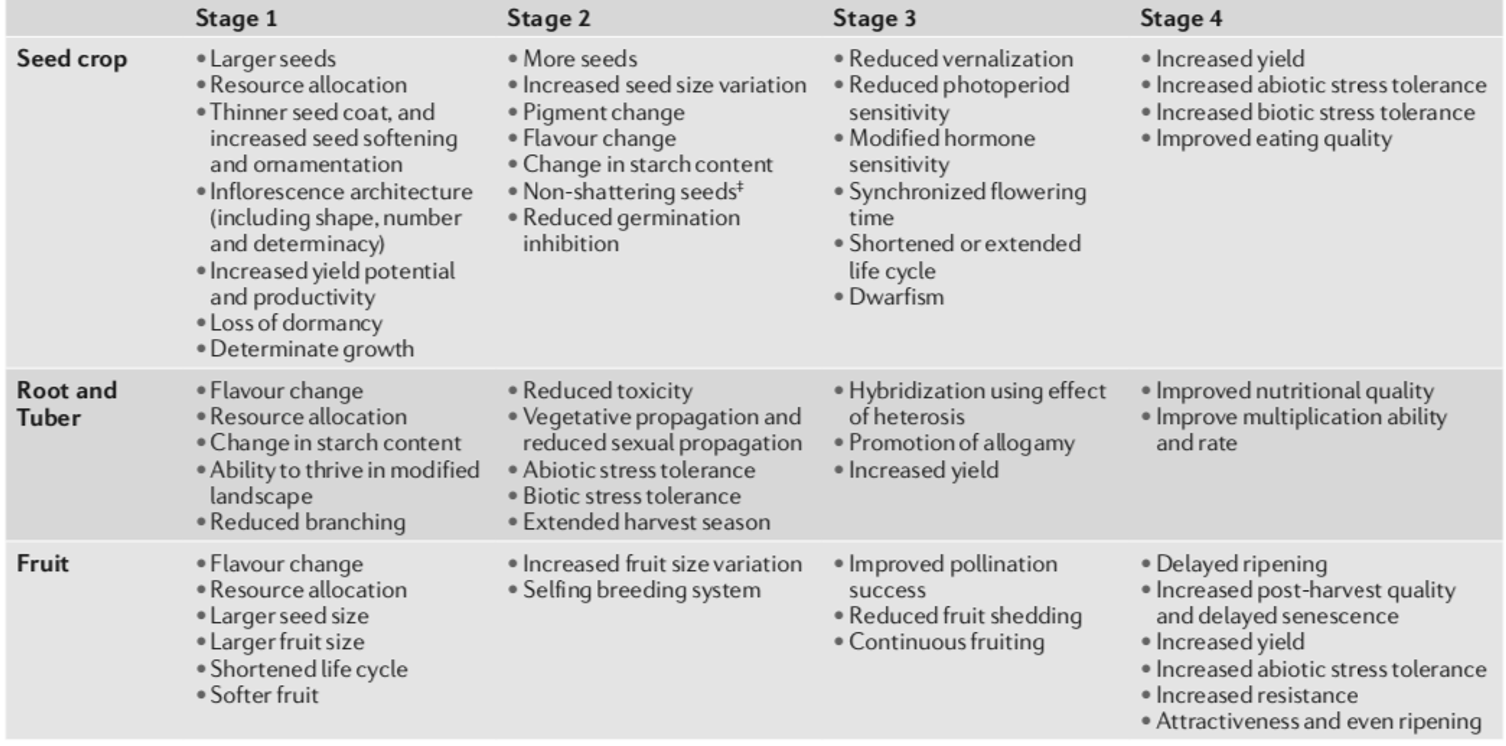Brief history of domestication LECTURE 1
1/36
There's no tags or description
Looks like no tags are added yet.
Name | Mastery | Learn | Test | Matching | Spaced |
|---|
No study sessions yet.
37 Terms
When hunter-gatheres started to cultivate
Start of the Holocene
began cultivation of plant species for
fibre
food
other uses
Why did they make the descision?
Unconcious inate descisions
unconsciously picked ones they liked the most when hunter gathering
then brought seeds with them to camps
accidental cultivation
Cultivations reinforced by
Pleistocene→ Climate change:
Risk of decreasing food supply
decrease available big game
increasing human occupation of local habitats
To descrease risk of decreasing food supply
gathered second and third choice food
e.g species that required food preparation
→ Began intentionally transporting wild plants to productive habitats
→ began controlled cultivation and breeding
Cons of being a farmer (vs Hunter-Gatherer)
more work
shorter stature
worse nutritional conditions
more disease in societies
BUT→ has still outcompeted hunter gatherer societies today
How did farming outcompete hunter gatherer
settle permantantly
not mirgation
→ Explosion in human popualation
How this human population explosion caused?
sedentary lifestyle→ shorter birth cycles
babies not carried on migration= more babies
greater density of edible foods (compared to wild distributions
FURTHER led to: technology, crafts, vocation, social stratification, political centralisation, standing armies
What is domestication
Process of speciation and/or species transformation
occurs when one species (domesticator) controls reproduction and dispersal of
another species (the domesticated)
→ In order to meet the needs of the domesticator (mainly fo food but could also e for e.g antibiotics or smth)
Domesticated crop species
result of evolutionary processses
acting at human time scales
not geological timescales
i.e→ humans inflict selection pressures on the domesticated
What causes the evo processes of domestrication
Wild species exposed to:
new selective environments (natural selection)
associated with with practices of agriculture and cultivation
Selection pressures from humans
e.g artificial selection
How is crop domestication a mutualistic relationship a co-evolution?
Plant species adapted to human control and surival under human manipulation to→ enhance Human survival
Domestication results in increased fitness of domesticated species
expansion of domesticated spcies outside its normal→ enhancing domesticated species pop size and survival
What this means e.g with Wheat
Relationship is tightly bound:
Wheat found on 218 million hecatres
→ If no wheat→ human pop decline and/or shown to have civil unrest (think of graph)
→ If no humans→ Wheat cannot thrive without cultivation
e.g now reliant on humans for dispersal (see loss of seed shattering below)
Plant vs animal domestication
1000-2500 plant species
20-31 mammal species
Why such a difference?
Non- human farmers
Bark beetles, termites and ants farming fungi
Ants farming plants
Non-human Domesticators→ Attine ants farming fungi
Farm fungi for food
cultivation of fungus gardens
Daughter queen leaves nest and carries fungus with her
Starts new garden
→ Crucial inter-dependence→ Shows the co-evolution→ Cannot live without eachother
E.g Attine ants→ Leaf cutter ants
cut forest vegtation
used as nutritional substrate for fungal gardens
When did ant farming evolve?
50000000 years ago
Much older than human farming
Attine ant agriculture→ with 4 separate organisms
Domesticator ants
Domesticated fungi
Parasitic fungus Escovopsis infect fungal gardens (pest)
Bacterium (symbiotic relationship with ants)→ controls the fungal pest
Non-human farmers: Ants farming plants
Plant produce domatia
hollow sweelings to house ants
ants gives plant
protection from predators
nutrients from feaces
Plants gives ants
sugary reward
E.g Ant: Philidris nagasau
Plant: Squamelleria→ epiphytic plant (grows on other plants)
How does Squamelleria work
extracts seeds
deliberately inserts them into cracks of host plant
germinate
Young plants grow→ ants protect them/ fertilise
EVEN the ants have shown to sow seeds on sunny side of trees→ optimise growing conditions
Origins of Domesstication
All originated in a number of dicrete areas in the world
→ Centres of origin
Characteristics of Centres of Origin
high co-occurence of wild ancesters with related domesticated species
Show higher varietal diversity comapred to other areas
because those domesticated and moved to new areas, favoured varieties→ bottle-neck
if area didnt have had as much or less diversity→ doesn’t really show that a trait was selected for and bottle necked!
Long history of crop use
Centres of Origin
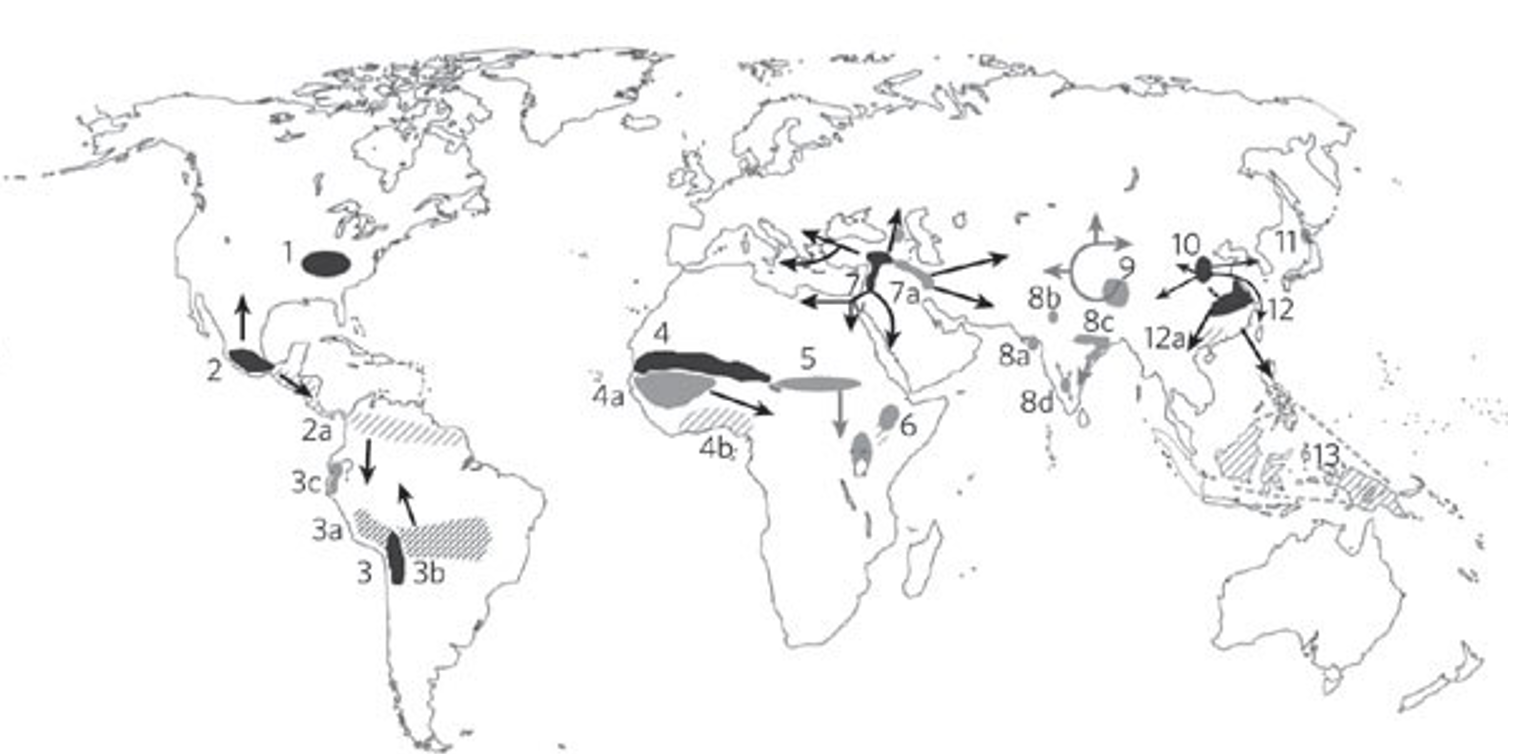
Spread of domesticated plants
More rapidly on the eat-west axis
WHY:
areas of same latitude
identical day-lengths and seasons
similar climates and habitats and disease
→ less evo change needed to domesticate species
→ Less technologies and practices needed
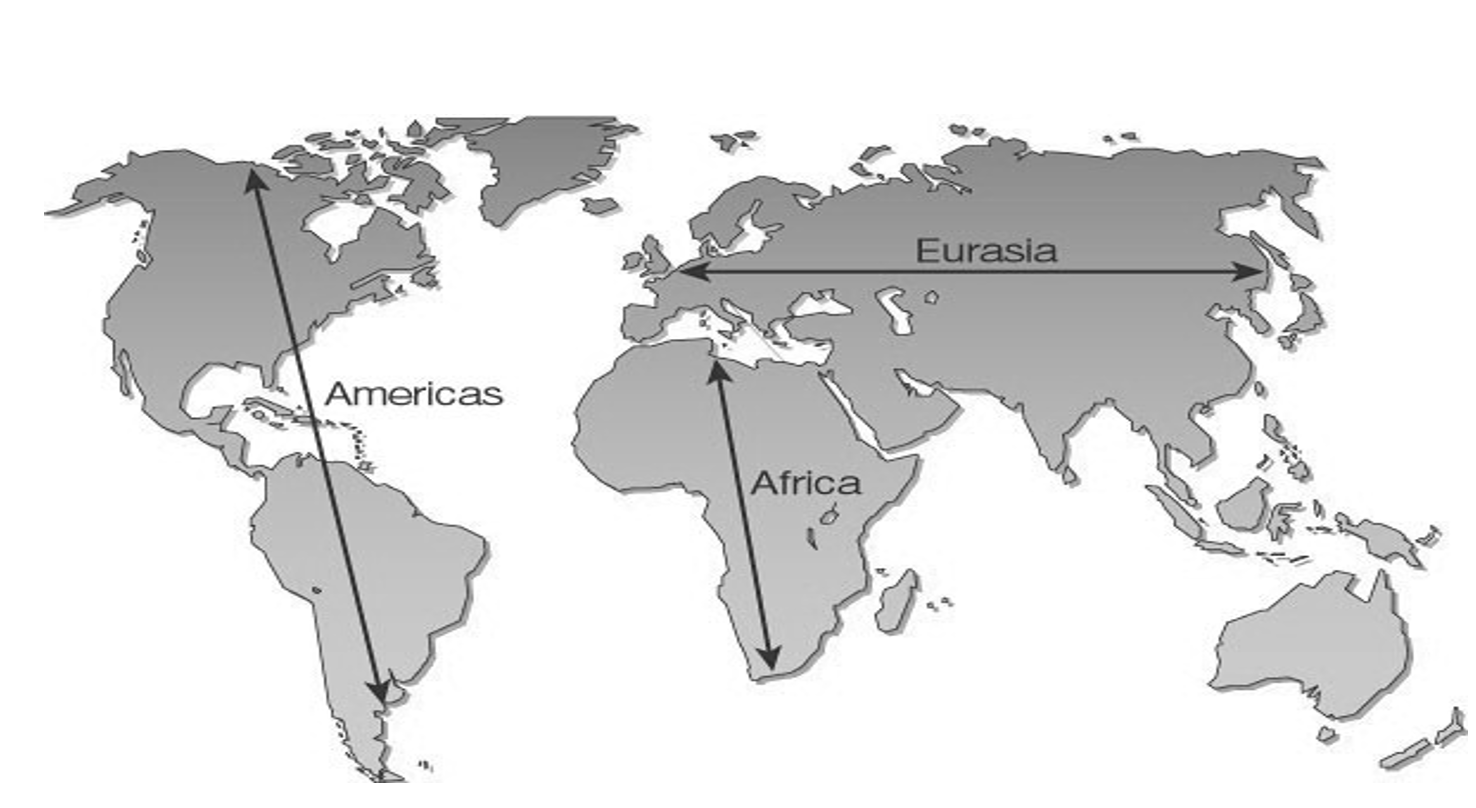
Multiple evolutionary origins of Domestication
we grow a range of stuff that its distantly related
But there are hotspots of domestication where crops have come from particular evolutionary lineages
some lineages: do not contribute anything at all!
Hotspots of evo lineages
Order Poales→ grass and cereal (rice, wheat barley oats)
Order Rosales→ temperate fruit species (apple pear plum)
Order Fables→ legumes (beans, legumes, chickpeas)
Solanales→ (tomato, potato, auberine, tobacco)
Why are osme lineages of plants so rich in example of crops and domestication, whilse others there are very few?
Domestication Syndromes
Traits that have been selected for and enhanced by humans to make the plant
more productive and nutritious
more amenable to cultivation
This results in…
plants that are distantly related having similar traits
Examples of domestication syndromes
Important note:
distinct phenotypic consequences that are shared
by domesticated plants
regardless
of geographical or organismal origin
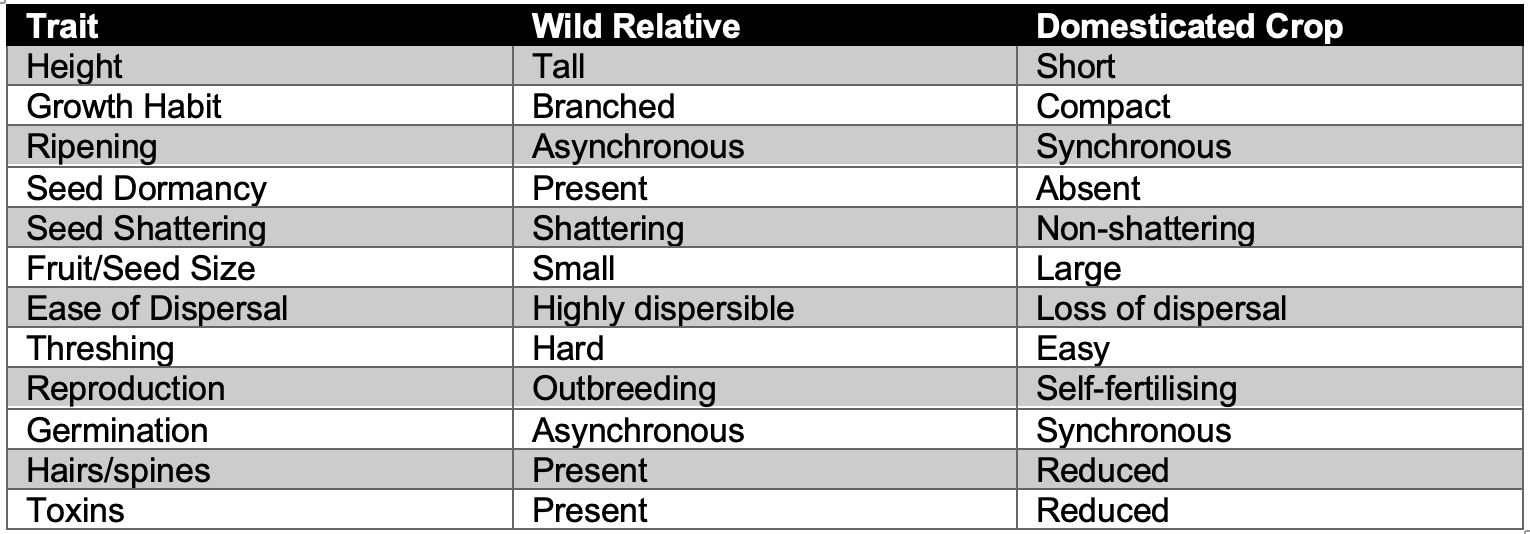
More subtle selection pressures for Domestication syndromes
Increased seed size and fruit size Wheat
larger seed= sown deeper and still emerge above ground
Shorter and less bushy maize vs Teosinte
Easier to access fruit, less resource wasted growing vegetation
Absence oof toxins and spines→ so can eat easier
Sync of germination and ripening
cultivation happen to whole crop at once
Reduced seed shattering and dispersal e.g wild rice
Really means that plant relies on human to spread seed
→ Co evolution and inter-dependence!
Self fertilisation
Not dependent on pollinators
limits potential for introgression of unwanted alleles
ensures beneficial traits are maintained
Angiosperms are the most successful group of plants on Earth.” To what extent do you agree with this statement? What features of angiosperms have contributed to their success?
Example: Increased grain size of wheat

Example: Reduced branching of modern Maize vs Teosinte
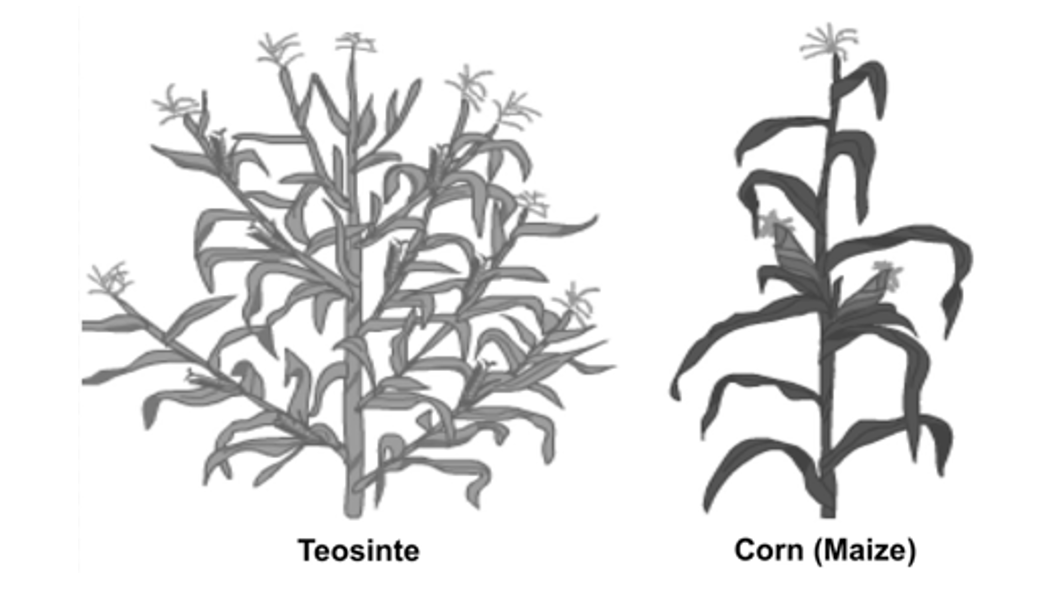
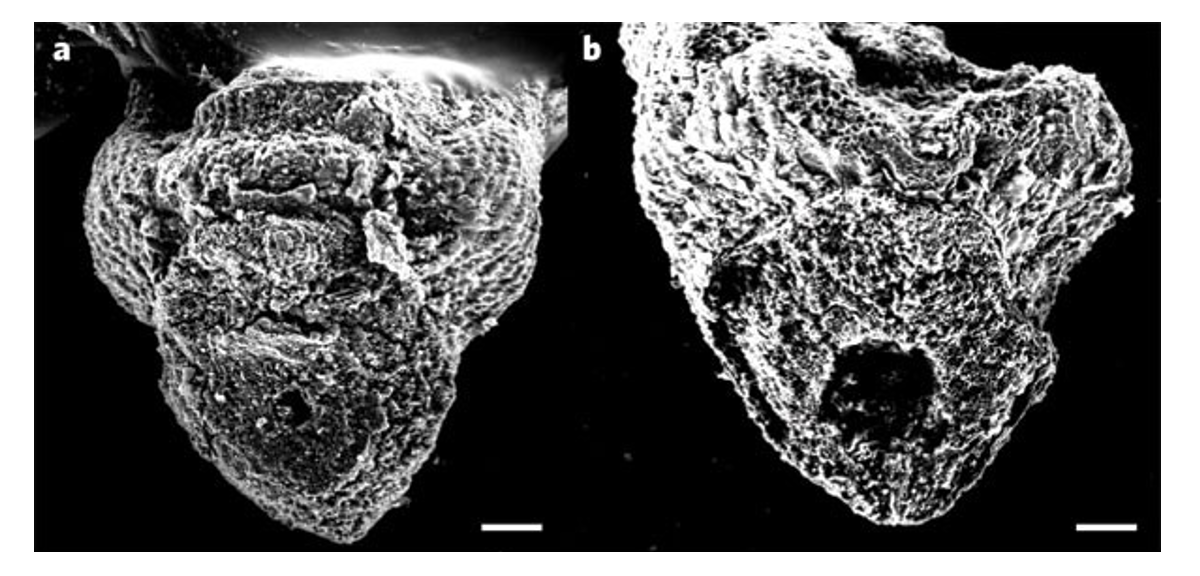
Example: Loss of abscission zone→ wild rice
Intentionally weakend abscission zone
Lost
Reduces seed dispersal

Points of domestication
Initiation:
Domestication
→ unconscious
Propagation
Diversification
→ evolution of the domesticated species
Also to different habitats
different traits coming into selection at different points
Stages of Domestication
Onset of Domestication (Initiation)
Plant exploitation, harvesting and stewardship
→ isolates it from wild relative
Increase in frequency of desired alleles
populations with desired alleles amplified
yield increases begin to be seen
diversity of phenotypes
Adaptation of pops to new environments
spread from centre of origin
now selected for even more different environments/ cultures
Deliberate breeding
different crop varieties (now that we have them from stage 3) deliberately bred to max:
yield, ease farming, uniformity and quality

E.g stages of Maize Domestication
merging distinction between
wild ancestor teosinte and
early form of Maize
Increases selection for desirable alleles
With a degree of variation (see picture)
Selection for different variteies by cultures
e.g Native Indians→ ornamental
e.g Peru → pop-corn
e.g Italy → red sweet corn
Modern varietal maize
result of dedicated breeding approaches
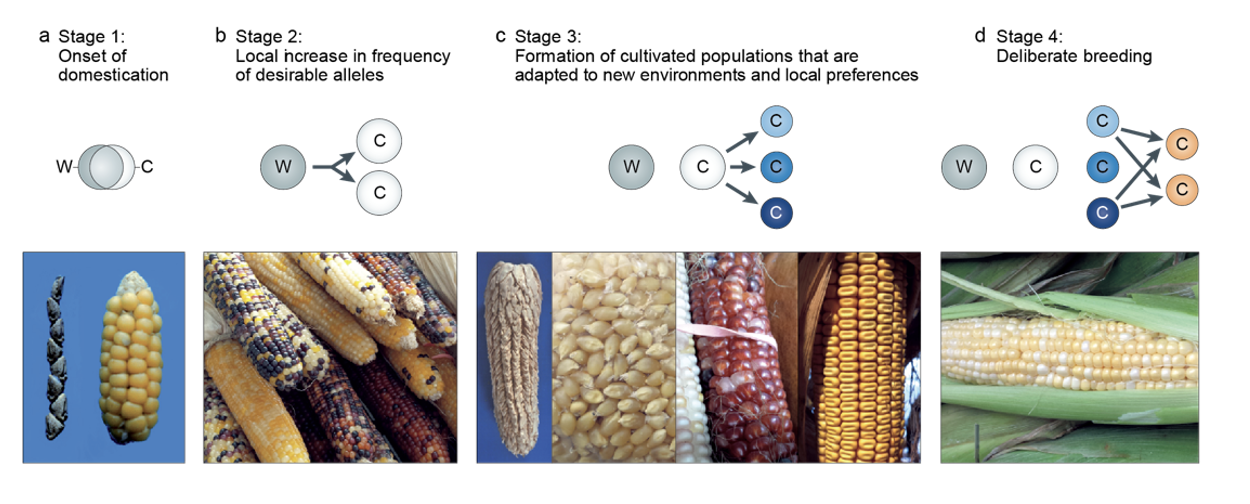
Other examples→ throughout stages, the traits selected for changes
